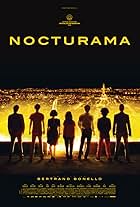IMDb RATING
6.6/10
13K
YOUR RATING
A jaded Japanese woman discovers a hidden copy of Fargo (1996) on VHS, believing it to be a treasure map indicating the location of a large case of money.A jaded Japanese woman discovers a hidden copy of Fargo (1996) on VHS, believing it to be a treasure map indicating the location of a large case of money.A jaded Japanese woman discovers a hidden copy of Fargo (1996) on VHS, believing it to be a treasure map indicating the location of a large case of money.
- Awards
- 10 wins & 8 nominations
Ichi Ômiya
- Library Security Guard
- (as Ichi Kyokaku)
- Director
- Writers
- All cast & crew
- Production, box office & more at IMDbPro
Storyline
Did you know
- TriviaKumiko is assisted by a well-meaning state trooper who brings her to a Chinese restaurant, hoping they could help translate. In real life, Takako Konishi was helped by a state trooper who really did contact Chinese restaurants in a vain attempt to help.
- GoofsWhen Kumiko calls her Mother in the middle of the night and tells her she couldn't sleep, it should have triggered some reaction from the mother. Because of the time difference between Minnesota and Tokyo (14 hours), it is never nighttime in Tokyo when it is in Minnesota.
- Crazy creditsThe credits are almost entirely bilingual in English and Japanese -- even though the movie has never been released in Japan as of early 2016 (either in theaters, media, or internet streaming).
- ConnectionsReferences Fargo (1996)
- SoundtracksMechanic Nonsense
Written by XiROH
Performed by Buddy Girl and Mechanic
Featured review
Viewers are asked to identify with the Coen Brothers' fictional "Fargo" and the reality of the Zeller Brothers' "Kumiko" (Rinko Kikuchi of Babel). Our leading lady on a treasure hunt for something we all crave – what we want.
Kumiko is insulated from the rest of the world through solitude, Her character cannot subscribe to Japanese societal norms and the journey is like many: weathering professional and personal criticism for not measuring up to the public barometer. She is hungry for the smallest dollop of approval. Frosty comrade pressures and a personal friend with child make the tiny Single made to believe she does not measure up. Even Mother is disappointed that she is still not married, a Japanese custom that girls are to wed by 25 or live at home.
Yet, our actress ventures out alone to find little gems wherever she goes, small hidden treasures that strengthen thoughts of another journey. She identifies best with her bunny Bunzo (Rabbit - symbol of rebirth and innocence). Emotionally drained, Kumiko cannot stay in a world that punishes her for not attaining expected behaviours. Mistaking make believe for real life, our disillusioned lead leaves native Japan penniless and fixated, but armed. She encounters Americans who unknowingly assist in her adventure. Blanketed in determination, our heroine explores self-abandonment, only to be rescued from the cold with local hospitality.
All this happens against a constant, white background of the silver screen, the Japanese symbol of death. This film leads viewers to decipher what is "not" real and what is. This film is a myth of fortune and the pursuit ... of what we each want. After watching, we may all realise we have been living a dream, maybe other's dreams and not our own. Her future may be someone else's chaos.
Kumiko is insulated from the rest of the world through solitude, Her character cannot subscribe to Japanese societal norms and the journey is like many: weathering professional and personal criticism for not measuring up to the public barometer. She is hungry for the smallest dollop of approval. Frosty comrade pressures and a personal friend with child make the tiny Single made to believe she does not measure up. Even Mother is disappointed that she is still not married, a Japanese custom that girls are to wed by 25 or live at home.
Yet, our actress ventures out alone to find little gems wherever she goes, small hidden treasures that strengthen thoughts of another journey. She identifies best with her bunny Bunzo (Rabbit - symbol of rebirth and innocence). Emotionally drained, Kumiko cannot stay in a world that punishes her for not attaining expected behaviours. Mistaking make believe for real life, our disillusioned lead leaves native Japan penniless and fixated, but armed. She encounters Americans who unknowingly assist in her adventure. Blanketed in determination, our heroine explores self-abandonment, only to be rescued from the cold with local hospitality.
All this happens against a constant, white background of the silver screen, the Japanese symbol of death. This film leads viewers to decipher what is "not" real and what is. This film is a myth of fortune and the pursuit ... of what we each want. After watching, we may all realise we have been living a dream, maybe other's dreams and not our own. Her future may be someone else's chaos.
Details
- Release date
- Country of origin
- Official sites
- Languages
- Also known as
- Kumiko, the Treasure Hunter
- Filming locations
- Production companies
- See more company credits at IMDbPro
Box office
- Gross US & Canada
- $623,383
- Opening weekend US & Canada
- $34,114
- Mar 22, 2015
- Gross worldwide
- $739,623
- Runtime1 hour 45 minutes
- Color
- Aspect ratio
- 2.35 : 1
Contribute to this page
Suggest an edit or add missing content

Top Gap
By what name was Kumiko, The Treasure Hunter (2014) officially released in India in English?
Answer





























